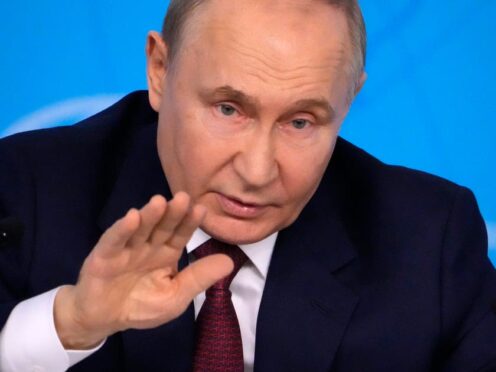
Russian President Vladimir Putin has called for resuming production in Russia of intermediate-range missiles that were banned under a now-scrapped treaty with the United States.
The Intermediate-Range Nuclear Forces treaty, which banned ground-based missiles with a range of 500-5,500 kilometres (310-3,410 miles), was regarded as an arms control landmark when then-Soviet leader Mikhail Gorbachev and US president Ronald Reagan signed it in the 1980s.
The United States withdrew from the treaty in 2019, citing Russian violations.

“We need to start production of these strike systems and then, based on the actual situation, make decisions about where – if necessary to ensure our safety – to place them,” Mr Putin said at a meeting of Russia’s national security council.
Mr Putin said Russia had not produced such missiles since the 2019 treaty scrapping, but that “today it is known that the United States not only produces these missile systems, but has already brought them to Europe for exercises, to Denmark. Quite recently it was announced that they are in the Philippines.”
Since the treaty was scrapped, the US has tested missiles that would have been banned by the INF treaty.
The Japanese newspaper Asahi Shimbun in April cited the US army’s Pacific commander General Charles Flynn as saying that such a missile would be deployed in the region by the end of the year. The report said such a deployment would be the first since the end of the treaty.
The end of the INF was a milestone in the deterioration of relations between the US and Russia.
The last remaining arms-control pact between Washington and Moscow is the New Strategic Arms Reduction Treaty, which limits each country to no more than 1,550 deployed nuclear warheads and 700 deployed missiles and bombers.
It is set to expire in 2026, and the lack of dialogue on anchoring a successor deal has worried arms control advocates.
Mr Putin’s statement comes amid rising tensions between Russia and the West over the conflict in Ukraine and concern about possible nuclear attacks.
Mr Putin in June spoke to executives from international news organisations about Moscow’s use of nuclear weapons.
“We have a nuclear doctrine, look what it says,” he said. “If someone’s actions threaten our sovereignty and territorial integrity, we consider it possible for us to use all means at our disposal. This should not be taken lightly, superficially.”

Enjoy the convenience of having The Sunday Post delivered as a digital ePaper straight to your smartphone, tablet or computer.
Subscribe for only £5.49 a month and enjoy all the benefits of the printed paper as a digital replica.
Subscribe